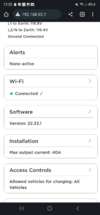I would have said something sooner, but did not pick up on this aspect of the install earlier in the thread. A Tesla is not a huge fire risk, no more so than a gasoline car, but that's not a zero risk. You don't have a long ways to run that wire to get to the garage wall, but it will require opening more drywall.
Also remember that if you have to create a junction (splice wire), in order to reach the garage, you will need an accessible junction box to hold it. You can't just bury the junction inside the wall.



